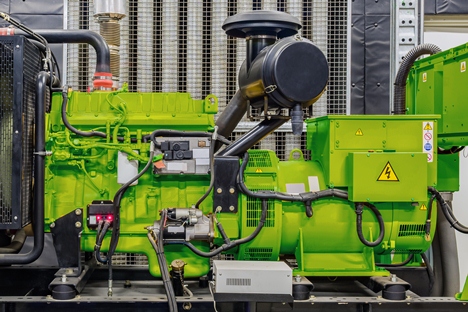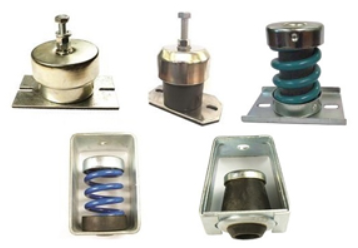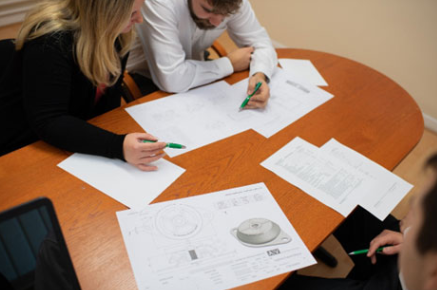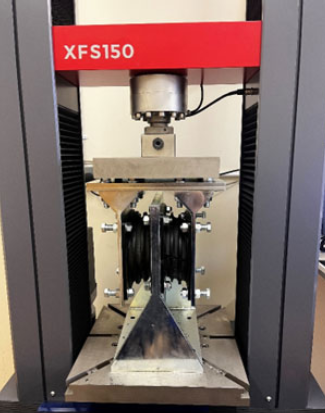The selection of anti-vibration mountings for generating sets is an important aspect when designing generators and their installation. Minimising structure borne vibration will protect against equipment failure, structural damage, disturbance to surroundings, and reduced operational efficiency. This technical guide will discuss the theory behind vibration isolation, the factors to consider when selecting anti-vibration mountings and the technical services required to ensure best performance.

Vibration in Generating Sets
Generating sets, particularly those powered by diesel engines, are prone to mechanical vibrations. These vibrations are created from different sources:
-
Out-of-Balance Forces: Resulting from the reciprocating motion of the engine components.
-
Gas Fluctuations: Caused by the combustion process within the cylinders, varying with the number of cylinders, firing order, and engine configuration.
A typical 4-cylinder diesel engine running at 1500 RPM (25 Hz) will generate a dominant 2nd order vibration harmonic at 50 Hz. This harmonic arises due to the difference in inertia forces during the upward and downward piston strokes and the associated combustion within the cylinders. While it is impossible to eliminate all vibrations, well-balanced engines combined with correctly selected anti-vibration mounts can reduce vibration by up to 99%.
Theory of Vibration Isolation
The theory behind vibration isolation is based on the relationship between the disturbing frequency (fd) of the generating set and the natural frequency (fn) of the anti-vibration mountings. The goal is to select mountings that provide a natural frequency significantly lower than the disturbing frequency to achieve vibration isolation.
Key Concepts:
-
Disturbing Frequency (fd): The frequency at which the generating set produces vibrations, typically based on the engine speed and harmonics.
-
Natural Frequency (fn): The frequency at which the anti-vibration mounting system vibrates naturally due to the weight of the generator and the mounting's static deflection.
-
Vibration Isolation Ratio: This ratio is determined by dividing the disturbing frequency by the natural frequency. Isolation occurs when the ratio is greater than 1.44, with isolation improving as the ratio increases.
Basic Isolation Formula:

Selection Criteria for Anti-Vibration Mountings
Selecting the correct anti-vibration mounting requires consideration of several factors:
1. Total Weight of the Generator Set: The combined weight, including the engine, alternator, and other accessories.
2. Centre of Gravity: Understanding the centre of gravity is crucial to evenly distribute the weight across all mountings, or alternatively allows the selection of different rubber hardness in each position.
3. Running Speed and Dominant Vibration Harmonic: The engine's running speed and the resulting dominant harmonic frequency.
4. Type of Application: Whether the generator is mobile (i..e, portable generators) or static will influence the choice of mounting.

5. Environmental Factors: Consideration of environmental conditions such as temperature, exposure to oil, chemicals and corrosive environments is important to consider when selecting materials for the mountings.
6. Inertia Base Considerations: For installations requiring high levels of isolation, an inertia base may be used to increase the system's mass, which reduces the natural frequency and increases inertia.
7. 6 Degrees of Freedom: The generator’s movement in all six degrees of freedom (translation in X, Y, Z axes, and rotation about these axes) can be analysed to ensure that the mountings provide adequate natural frequency in all directions.
Types of Anti-Vibration Mountings
Two types of anti-vibration mountings are typically used in generating sets:

-
High Damping: Rubber mounts offer increased damping compared to spring mounts, providing better control during start-up, shut down, and resonance.
-
Deflection: Typically offer deflections between 2.5mm to 8mm, making them suitable for most industrial applications.
-
Isolation Efficiency: Capable of achieving up to 90% isolation, suitable for many standard installations.
-
Captive Restraints: These mounts can be designed with captive restraints, making them ideal for mobile applications.
Spring Mounts:

-
High Deflection: Providing higher deflections, typically around 25mm and up to 50mm, resulting in a lower natural frequency and higher vibration isolation.
-
Low Damping: Spring mounts have lower damping, which can lead to issues during transient conditions like start-up and shut down, and may require additional control buffers.
-
High Isolation: Can provide up to 99% isolation, making them suitable for critical applications where minimal vibration transmission is required, such as hospitals, school, and residential areas.

Installation and Technical Services
To ensure high performance of the mounting system, a technical engineer can offer a range of technical services to ensure correctly selected anti-vibration mountings, which can include:
Structural Assessment: Engage a structural engineer to assess the supporting structure's stiffness and rigidity. If necessary, consider the use of inertia bases or structural modifications.
Vibration Analysis: Conduct a detailed vibration analysis using 6 Degrees of Freedom computer modelling to calculate the generator's frequencies.

Dynamic Stiffness and Damping Factors: Consider the dynamic stiffness and damping properties of the rubber or spring materials, as these influence the mounting systems response to vibration.
Flexible Connections: Ensure all connections (exhausts, pipework, ducting) are flexible to accommodate the movement allowed by the mountings without creating additional stresses on the system.

The selection of anti-vibration mountings for generating sets is an important process that requires an understanding of vibration theory, non-linear material properties, and application factors.
By carefully considering these factors and engaging technical engineering support, you can ensure that your generating set operates efficiently with minimal vibration induced damage, leading to a longer operational life and reduced maintenance costs.
For critical applications, consulting with a Vibration Control Engineer is recommended to optimise the system's performance and ensure long term reliability.
The Technical Team at AV Industrial Products Ltd are at hand to support you with mounting selection. Contact us now at engineering@avindustrialproducts.co.uk




